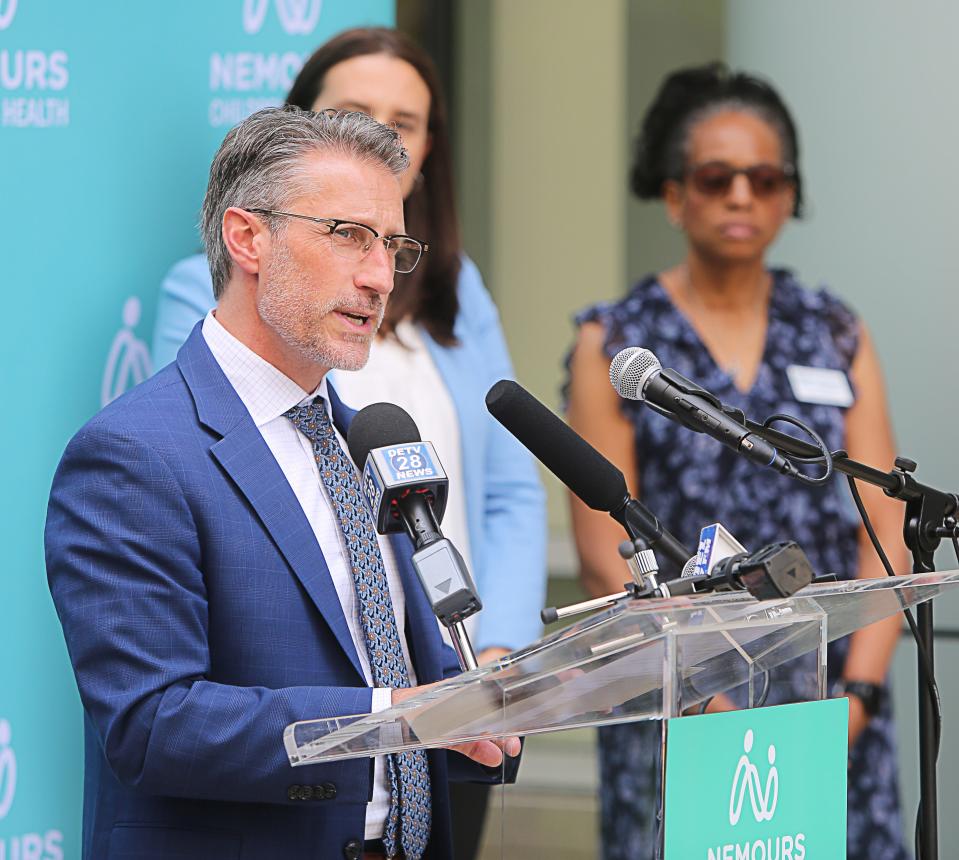New report calls on Delaware to spend more, update school funding to follow students
Most people know Delaware has an old system for funding its schools. Try over 80 years old.
Fewer could probably explain that unit-based formula, focusing on inputs to instruction, as billions in state funds are allocated among public school districts. But this week's announcement was about more than that.
This week, a long-awaited independent assessment on Delaware's education funding system was released. It's the latest development following a 2020 settlement, after Delawareans for Educational Opportunity and the NAACP sued the state for being aware of deficiencies in resources provided to lower-income students, students with disabilities and multilingual learners.
As expected, it recommends some sizable changes.
American Institutes of Research, the national firm executing the analysis, not only concluded "an alarmingly clear and negative relationship exists between the percentage of low-income students served by schools and the outcomes they achieve for students" — but also sets forth recommendations that the First State update its funding formula to follow students.
The recommendations, at a glance:
Increase overall state investment in public education.
Distribute more resources according to student need.
Implement a weighted student funding formula for the state.
Improve funding transparency.
Allow more flexibility in how districts use resources.
Regularly reassess property values.
Simplify the calculation of the local share provided to charter schools, while a formula is applied consistently to both districts and charter schools.

This could mean updating the funding system to add certain "weights" — or more funding — based directly on student needs, aiming to ensure greater success for learners who need more support. This resembles current Delaware efforts with opportunity funding, also a result of the 2018 lawsuit.
It also suggests officially taking into account other differences among districts, like smaller tax bases, in the state funding formula. According to the research group, such "equalization funding," has been long-due for an update and was described by district administrators as “broken” and “flawed.”
All of this and more would be largely new for Delaware.
And as of Tuesday, they remain just recommendations.
"What we've seen in other states is they get these reports, and they go through and say: What do we love? What do we like? And what do we hate?" said Qubilah Huddleston, policy lead on equitable school funding with The Education Trust, ahead of Tuesday's release.
"And I think there's that opportunity. I don't think we've seen states do a total throwing-the-baby-out-with-the-bathwater."
What were the biggest recommendations for change?

The research group puts it plainly.
"Delaware’s student outcomes lag behind those of other Mid-Atlantic states and have declined over thepast decade, even prior to the COVID-19 pandemic," reads the report. "Delaware’s current outcomes also do notmeet the stated goals for K-12 student performance."
One barrier to this target, the report contends, is massively underspending on education. The analysis recommends Delaware invest roughly $600 million to $1 billion more in its schools, relative to 2021–22 education spending levels.
Next, comes hopes for equity.
Delaware's current system — in which opportunity funding provided an additional $616 per student from low-income background and $616 for every multilingual learner student starting in 2021 — sees "marginally more" spent on schools serving high-needs students, according to the report. That includes lower-income, English learners and students living with disabilities.
Tuesday's findings suggest this additional spending is not enough. It recommends a base funding per student around $10,000 — while recommending policymakers consider allotting funding "more strongly based on student needs, providing more to schools with the highest needs." Other weights could include special programs, grade groups, district population density, school enrollment and geographic costs, according to the report.
School funding 101: How a major settlement does (and doesn't) change how Delaware pays for its schools
Equity among school districts also made its way into the 200-plus pages.
Delaware’s salary schedule was described as a possible "barrier to improved equity." Schools with more lower-income students were found to have less experienced teachers with lower salaries, on average, than otherwise similar schools with lower percentages of low-income students.
Property tax and local revenue raised also vary widely across districts, while state revenue is minimally differentiated across districts in Delaware. That system was deemed "insufficient," as the report recommended updates in equalization funding in a new formula and regular property reassessments.
Researchers anticipate few districts, if any, will see target funding less than what they currently receive. But if it did become the case after a new system was phased-in, the state would need a "hold-harmless policy" to ease those schools into lesser state funding. Referenda requirements would remain.
Experts called this segment one of the most politically sensitive.
"Anytime you're changing a state funding policy, and your goal is to change the way funding is allocated, you are going to potentially create winners and losers," said Jennifer O’Neal Schiess, senior partner and policy and evaluation practice leader with Bellwether, a national nonprofit that focuses on equity within education systems.
"There's a lot of political capital that will need to be spent to get this done, most likely, but I think it is possible."
This could be addressed by updating the formula at its roots.
What's next for Delaware education funding?

This report suggests finding a principle formula that can hold more money, be easily communicated and allocate dollars instead of positions.
Even if it had grown predictable and stable to many of them, Delaware's current unit system often left education leaders from charters to districts concerned about transparency. Some positions and pots of money are allocated outside of the main unit formula, each with its own formulas and rules, leaving the big picture hard to lay out.
And the system is atypical. Most states, like New Jersey and Maryland, use systems that allocate dollars to districts through student weights, according to the research group, accounting for both state and local revenue. In that way, local share varies across districts according to the capacity to raise revenue locally.
"When you have a more simplified system, where every student is funded at the same in terms of the base amount, and then you're adding on additional funding for specific students that face specific barriers to learning — that is something that people can understand," Huddleston said.
The research group knows these tenants could be folded, at least in part, into Delaware's current formula. However, researchers note their recommendations "would be most easily implemented through a foundation formula that uses student weights to distribute dollars to districts and charter schools."
Peek behind the curtain: Wilmington Ballet's 56th annual production of The Nutcracker
What comes next?
As ACLU of Delaware sees it, there's no time to wait.
"While they frame it as a recommendation, I really see this as a mandate," said Dwayne Bensing, legal director with ACLU-DE. "It's an indictment of our system, and the General Assembly must act."
If not, he said, Tuesday's report "is Exhibit A" in the next litigation.
This report will now be submitted to the governor, secretary of education, speaker of the house, senate pro tempore and education committees. It is also available online for anyone to dig into it. The research group suggested a phase-in plan for implementation.
"It's all about getting students what they need," said Secretary of Education Mark Holodick, addressing a launch event for the assessment Tuesday morning. "And our current funding system isn't doing that nearly well enough. The recommendations in this report, if acted upon appropriately, will — in a much more effective, efficient and appropriate manner that addresses equity."
Holodick told a crowd of well over 100 that Delaware cannot be set in its old ways. Time will tell where lawmakers go from here.
"You need a political champion," O’Neal Schiess said. "Or a set of political champions, who have the power and the influence to move the conversation."
Got a story? Kelly Powers covers race, culture and equity for Delaware Online and USA TODAY Network Northeast, with a focus on education. Contact her at kepowers@gannett.com or (231) 622-2191, and follow her on Twitter @kpowers01.
This article originally appeared on Delaware News Journal: Report calls on Delaware to update 80-year-old school funding system

